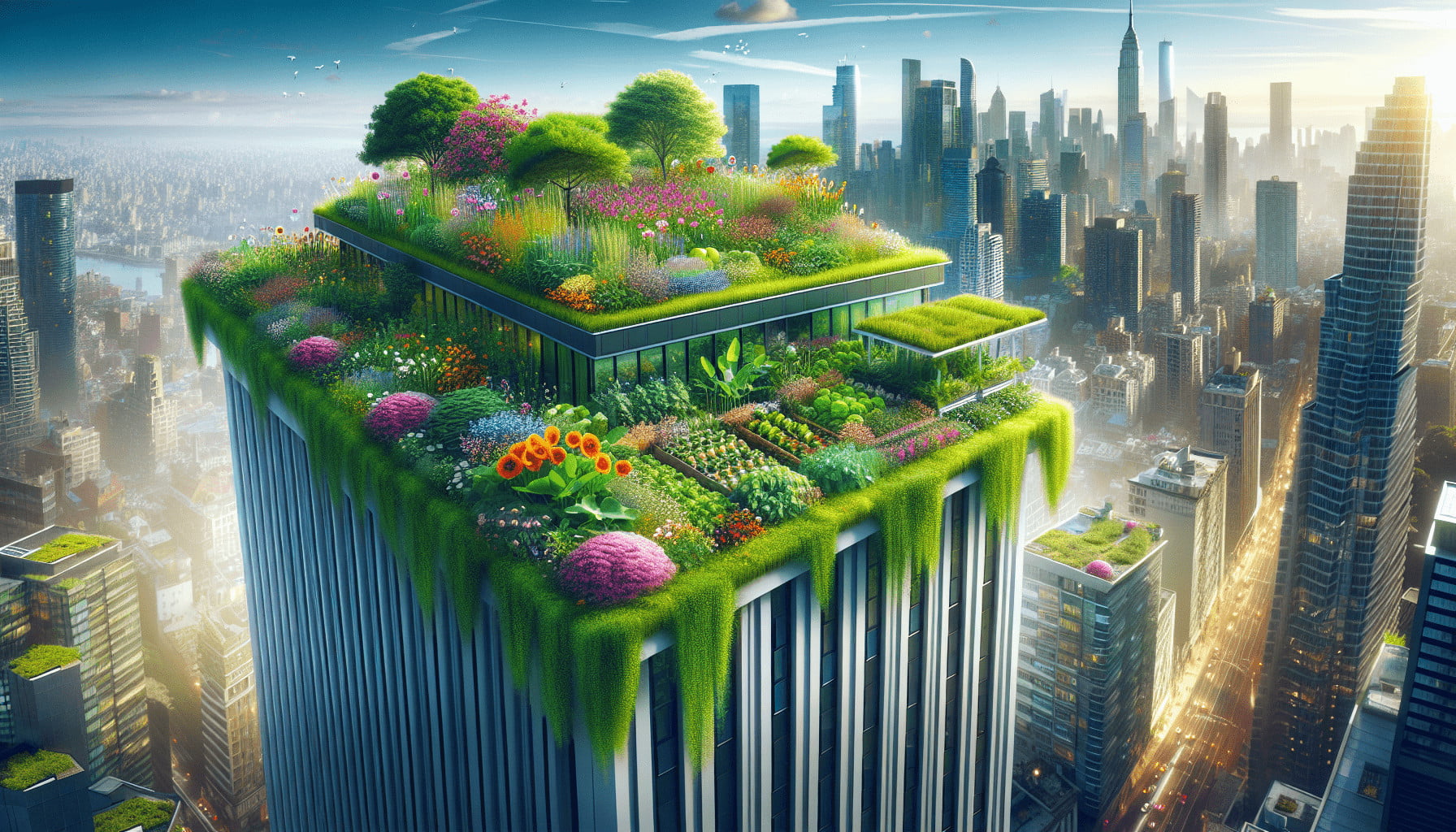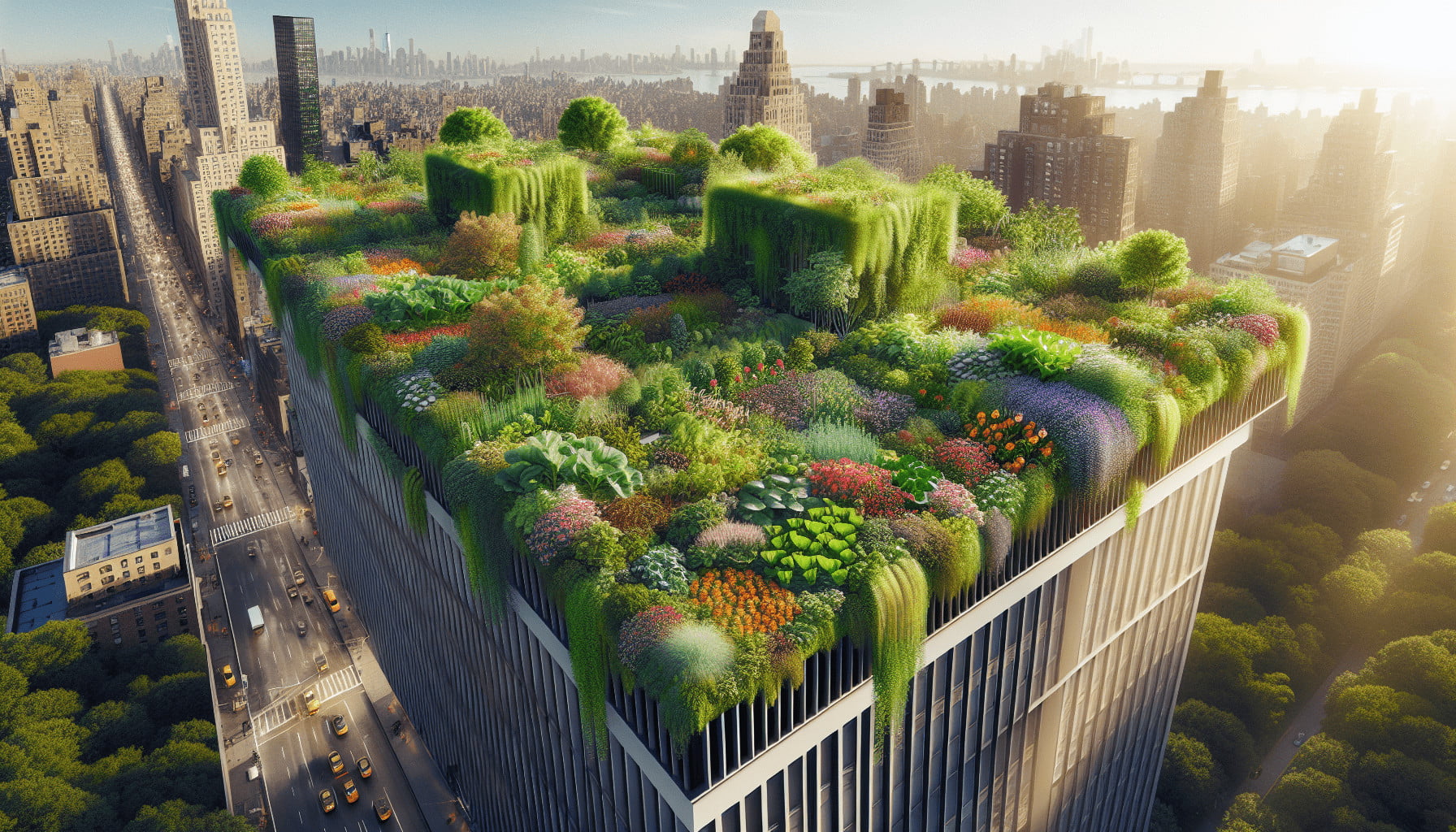Have you ever considered adding a green roof to your rooftop garden? If you’re looking to enhance the beauty and functionality of your garden space, a green roof could be the perfect addition. Not only does it provide numerous benefits for both your garden and the environment, but it can also add a unique and visually appealing element to your outdoor space. Let’s explore the benefits of adding a green roof to your rooftop garden together.

What is a Green Roof?
A green roof, also known as a living roof or eco-roof, is a roof system that is partially or completely covered with vegetation. These roofs can vary in complexity, from simple sedum mats to fully landscaped gardens, depending on your preferences and budget. Green roofs are becoming increasingly popular in urban settings as they offer a wide range of benefits both to the building and the local ecosystem.
Benefits of a Green Roof
Adding a green roof to your rooftop garden can bring a multitude of benefits to both your property and the environment. These benefits include:
- Stormwater Management: Green roofs absorb rainwater and help reduce stormwater runoff, which can help alleviate strain on city sewer systems during heavy rain events.
- Energy Efficiency: A green roof can act as an insulating layer, helping to regulate the temperature inside your building and reducing the need for heating and cooling. This can lead to lower energy bills and decreased carbon emissions.
- Improved Air Quality: Green roofs absorb carbon dioxide and release oxygen, helping to purify the air and reduce air pollution in urban areas.
- Biodiversity: Green roofs provide habitat for birds, insects, and other wildlife that may be displaced by urban development. This can help support local ecosystems and promote biodiversity in urban environments.
- Aesthetic Appeal: A green roof can add a unique and visually appealing element to your rooftop garden, creating a peaceful and relaxing oasis in the middle of the city.
By adding a green roof to your rooftop garden, you can not only enhance the beauty and functionality of your outdoor space but also contribute to a more sustainable and eco-friendly urban environment.
Types of Green Roofs
There are several different types of green roofs that you can choose from, each with its own benefits and considerations. The three main types of green roofs are:
- Extensive Green Roofs: These are the most common type of green roof and are typically low maintenance. They are planted with hardy, drought-tolerant plants like sedum, grasses, and herbs that require minimal watering and care.
- Intensive Green Roofs: Intensive green roofs are more like traditional gardens and can support a wider variety of plant species, including trees, shrubs, and flowers. These roofs require more maintenance and irrigation but offer greater flexibility in terms of design and plant selection.
- Semi-Intensive Green Roofs: Semi-intensive green roofs fall somewhere between extensive and intensive roofs in terms of maintenance and plant selection. They support a mix of low-maintenance and more water-intensive plants and offer a balance of visual appeal and practicality.
When choosing the type of green roof for your rooftop garden, consider your desired level of maintenance, water requirements, and aesthetic preferences. Consulting with a professional green roof installer can help ensure that you choose the right type of green roof for your specific needs and budget.
Installation Considerations
Before installing a green roof on your rooftop garden, there are several important considerations to keep in mind. These considerations include:
- Structural Integrity: Green roofs add additional weight to your building, so it’s essential to ensure that your roof can support the extra load. Consulting with a structural engineer can help determine if your building is suitable for a green roof.
- Drainage: Proper drainage is crucial for the success of a green roof. Ensure that your roof has adequate drainage systems in place to prevent water accumulation and potential leaks.
- Access and Maintenance: Consider how you will access your green roof for maintenance tasks like watering, weeding, and plant care. Installing a roof hatch or ladder can make maintenance easier and safer.
- Local Regulations: Check with your local government or building department to ensure that green roofs are allowed in your area and comply with any regulations or guidelines that may apply.
By taking these considerations into account before installing a green roof, you can ensure a successful and long-lasting addition to your rooftop garden that will provide many benefits for years to come.
Plant Selection
Choosing the right plants for your green roof is essential to its success and longevity. When selecting plants for your rooftop garden, consider the following factors:
- Climate and Environment: Choose plants that are well-suited to your local climate and growing conditions. Opt for drought-tolerant species that can thrive in the harsh conditions of a rooftop environment.
- Weight and Root Depth: Select plants with lightweight soil requirements and shallow root systems to prevent damage to your roof structure. Sedum, grasses, and succulents are excellent choices for green roofs.
- Aesthetic Appeal: Consider the color, texture, and growth habits of the plants you choose to create a visually appealing and cohesive design. Mix different plant species to add interest and variety to your green roof.
- Wildlife Habitat: Select plants that attract pollinators like bees and butterflies to help support local ecosystems and promote biodiversity on your green roof.
Working with a knowledgeable landscape designer or green roof installer can help you select the right plants for your rooftop garden and ensure that your green roof thrives and flourishes over time.

Maintenance Requirements
While green roofs are generally low maintenance compared to traditional gardens, they still require regular care and attention to thrive. To keep your green roof healthy and beautiful, consider the following maintenance tasks:
- Watering: Green roofs typically require less water than traditional gardens but may need supplemental irrigation during dry periods. Check the soil moisture regularly and water as needed to keep your plants healthy.
- Weeding: Keep an eye out for weeds and unwanted plants that may sprout in your green roof. Regularly remove weeds to prevent them from overcrowding your plants and competing for nutrients.
- Fertilizing: Green roofs may benefit from occasional fertilization to replenish nutrients in the soil and promote healthy plant growth. Use a slow-release or organic fertilizer to avoid damaging the plants or the environment.
- Pruning: Some plants on your green roof may require occasional pruning to maintain their shape and size. Trim back overgrown plants to encourage new growth and prevent overcrowding.
- Inspections: Periodically inspect your green roof for signs of damage, pests, or other issues that may affect plant health. Address any problems promptly to prevent further damage and ensure the long-term success of your green roof.
By following these maintenance guidelines, you can help ensure that your green roof remains healthy and vibrant for years to come, providing numerous benefits for your rooftop garden and the environment.
Cost Considerations
Adding a green roof to your rooftop garden can be a significant investment, so it’s essential to consider the costs involved before making a decision. The cost of a green roof can vary depending on several factors, including:
- Type of Green Roof: Extensive green roofs are generally more affordable than intensive or semi-intensive green roofs due to their lower installation and maintenance costs.
- Size and Complexity: The size and complexity of your green roof will also impact the cost, with larger and more intricate designs costing more to install and maintain.
- Structural Modifications: If your building requires structural modifications to support a green roof, this can add to the overall cost of the project.
- Labor and Materials: Labor and materials are significant costs in green roof installations, so be sure to get several quotes from reputable installers to compare prices.
While the initial cost of a green roof may be higher than a traditional roof, the long-term benefits and savings can outweigh the upfront investment. Consider the potential energy savings, increased property value, and environmental benefits when calculating the overall cost of adding a green roof to your rooftop garden.
Environmental Impact
Green roofs have a positive environmental impact on both the local ecosystem and the planet as a whole. By adding a green roof to your rooftop garden, you can help mitigate several environmental issues, including:
- Urban Heat Island Effect: Green roofs help reduce the urban heat island effect by absorbing heat and providing cooling through evapotranspiration. This can help lower temperatures in urban areas and reduce the need for air conditioning.
- Air Pollution: Green roofs help filter out pollutants and particulate matter from the air, improving air quality and reducing health risks associated with air pollution in urban environments.
- Carbon Footprint: By lowering energy consumption and reducing carbon emissions from heating and cooling, green roofs help combat climate change and promote a more sustainable and eco-friendly urban environment.
- Stormwater Management: Green roofs reduce stormwater runoff and prevent pollutants from entering waterways, helping to protect water quality and prevent flooding in urban areas.
By adding a green roof to your rooftop garden, you can contribute to a healthier and more sustainable urban environment, benefitting both the local ecosystem and the broader planet.
Conclusion
Adding a green roof to your rooftop garden is a fantastic way to enhance the beauty and functionality of your outdoor space while promoting environmental sustainability. Green roofs offer a wide range of benefits, including stormwater management, energy efficiency, improved air quality, biodiversity, and aesthetic appeal. By choosing the right type of green roof, selecting suitable plants, and following proper maintenance guidelines, you can create a thriving and eco-friendly oasis in the heart of the city.
Whether you’re a seasoned gardener looking to take your rooftop garden to the next level or a newcomer interested in exploring the world of green roofs, adding a green roof to your rooftop garden is a rewarding and worthwhile investment that will bring you joy and benefits for years to come. So why wait? Start planning your green roof project today and enjoy the numerous advantages of a greener, more sustainable rooftop garden.
